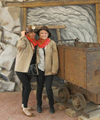November
Mexicans help keep Cornish traditions alive

Cornish pasties might be a traditional British staple but one student discovered they are also thriving thousands of miles away in Mexico.
A legacy of the Cornish miners who went over in the 1800s, these North American hybrids known as ‘paste’ now come in many different guises, most commonly refried beans and chorizo.
History student Ester Pink will be presenting her research into how Cornish identity has been preserved and handed down the generations at a special public lecture at Newcastle University tomorrow (Wednesday 20 Nov 2013).
This summer, supported by Newcastle University Expedition funding, she traced the steps of the original Cornish miners in 1824 who endured months of arduous travelling over sea and land to work in the Mexican silver mines.
“Back then, Cornwall was to the mining world what Silicon Valley is to the digital age,” she explained. “Cornish miners, or Cousin Jacks as they were known, had an excellent reputation – if you wanted the best miners, that’s where you got them from.
“A lot of them didn’t last long though, once they realised Mexico wasn’t the Eldorado they’d been promised.
“Many of the women made beautiful gowns before they left, hoping to impress Mexican high society when in fact they were in a tiny village miles from anywhere.”
For the first few years, the mining families lived on company land in Real de Monte, near Pachuca, but they gradually moved out into the community, with many of the miners marrying Mexican women.
Their wives soon learned how to make Cornish pasties, which is when they began to evolve – chilli was added, they became more potato than meat, and a new version using refried beans and mashed up chorizo emerged.
The original recipe had to be adapted quite a bit as there was no lard or shortening to be found in the local markets and also a lack of variety in available vegetables – cactus was the local staple.??However, as the miners were paid up to 20 times what the locals earned, they were gradually able to obtain some of the necessary ingredients which would have been beyond the reach of most of the villagers.
Over the last few years, pasties have been made commercially for the tourist market, with new flavours such as cheese, ham and pineapple being developed, but the old family recipes still remain a closely guarded secret.
“Everyone has a different way of making pasties and a lot of work goes into it,” says Ester. “They are fiercely protective of their recipes.
“There’s now a local pasty makers guild, an international pasty festival every October and the world’s only pasty museum where you can learn how to make them.”
The focus of Ester’s expedition was how migrant communities adapt while maintaining their own identity. “The written history of the time is rather dry and technical, with very little about the stories behind the miners’ families who settled here, especially the Cornish women, so I wanted to bring this to life,” she explains.
“They weren’t just making pasties – they took it upon themselves to educate the children and set up a school which records suggest has always been run by women - one of them served as the school’s director for 74 years.”
Over the years the Cornish identity has remained strong in the region - as well as pasties, the first football match in Mexico was played in Real del Monte, where the miners settled; an English school was set up which still teaches bi-lingual classes today; and there is a British Cemetery, which is the first overseas site to join the Cornish Mining World Heritage Association.?
Ester (pictured at the pasty museum) will be joined by other speakers presenting at Newcastle University’s Expedition and Research Scholarship lecture, including Kevin Harrison (BSc Computer Science – Game Engineering) who has developed an interactive storybook for tablets which can help rehabilitate children with cerebral palsy.
In the lead up to next year’s 100th anniversary of the start of the First World War, research by Benjamin Howson and Holly Johnson (both BA Hons History and Archaeology) is especially timely. They will be talking about their project which aims to incorporate the existing memorial in the foyer of the Armstrong Building more fully into the University community. The memorial marks the 223 staff and students from Armstrong College (as the University was known then) who fought and died on the battlegrounds.
A detailed survey carried out by surveying and mapping science students in Anegada, British Virgin Islands will contribute to future monitoring by the island’s Department for Disaster Management. Larissa Ord, Lauren Tawn, Joshua Dack and Chris Halliday carried out boundary mapping to highlight particular areas of concern as sea-level rise and tropical storms make this low-lying area particularly susceptible to coastal erosion.
BA Hons Biomedical Genetics student Jennifer Taylor will also be talking about her work into how genetic variation in the Clusterin gene has been associated with vascular and neurodegenerative diseases of the brain such as Alzheimer’s Disease.
The University Research Scholarships support undergraduate students to work alongside researchers on summer vacation projects. Through the Expeditions Scholarships, students undertake field research in other countries. Both these schemes enable students to experience research-led learning and to develop key skills. Last year, 80 Research Scholarships and three Expeditions were funded.
Admission is free to the public lecture, which takes place in the Curtis Auditorium of the Herschel Building, Newcastle University from 5.30pm until 7.30pm on Wednesday 20 November 2013. Posters from all the participants will also be on display in the Lindisfarne Room from 4.30pm.
For more information about the expeditions and research scholarships, visit the website.
Admission is free to the public lecture, which takes place in the Curtis Auditorium of the Herschel Building, Newcastle University from 5.30pm until 7.30pm on Wednesday 20 November 2013.
published on: 19 November 2013
